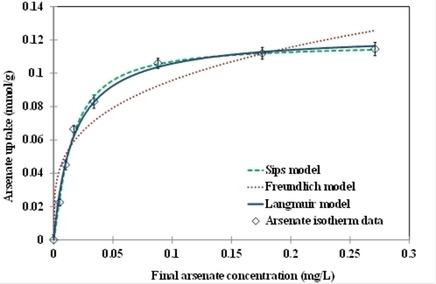当前位置:
X-MOL 学术
›
ChemistrySelect
›
论文详情
Our official English website, www.x-mol.net, welcomes your
feedback! (Note: you will need to create a separate account there.)
Batch and Column Arsenate Sorption Using Turbinaria ornata Seaweed Derived Biochar: Experimental Studies and Mathematical Modeling
ChemistrySelect ( IF 1.9 ) Pub Date : 2020-03-25 , DOI: 10.1002/slct.202000548 Krishnan Saravanakumar 1 , Ramalingham Senthilkumar 1 , Donipathi Mogili Reddy Prasad 2 , Balakrishna Sankari Naveen Prasad 3 , Sathyamoorthy Manickam 4 , Vasu Gajendiran 3
ChemistrySelect ( IF 1.9 ) Pub Date : 2020-03-25 , DOI: 10.1002/slct.202000548 Krishnan Saravanakumar 1 , Ramalingham Senthilkumar 1 , Donipathi Mogili Reddy Prasad 2 , Balakrishna Sankari Naveen Prasad 3 , Sathyamoorthy Manickam 4 , Vasu Gajendiran 3
Affiliation

|
The ability of Turbinaria ornata seaweed derived biochar (TOB) to remove arsenate ions from polluted solutions in batch and column trials has been investigated. The biochar, produced at 300 °C and 120 min through pyrolysis, exhibited maximum arsenate sorption capacity at pH 4. Batch sorption isotherm was described with different models (Freundlich, Langmuir and Sips) and the Sips model best described the experimentally derived isotherm with high correlation coefficient and low percentage error values. The maximum arsenate sorptional capacity calculated using the Langmuir model was estimated to be 0.124 mmol/g (at pH 4; 2 g/L biochar dosage and 0.5 mmol/L initial arsenate concentration). For elution trials, 0.01 M NaOH performed well to desorb arsenate from arsenate‐bounded TOB with elution efficiency greater than 99.6% with no significant damage to TOB. The capability of TOB to sorb arsenate continuously was examined in a packed column. The continuous trials were mainly performed to evaluate the impact of influential column parameters including bed height, initial arsenate concentration and flow rate. The arsenate sorptional capacity declined with improvement in flow rate, whereas enhanced with increment in bed depth and initial arsenate concentration values. Regeneration of exhausted TOB was possible with 0.01 M NaOH. After three sorption‐elution cycles it was determined that TOB exhibited superior sorption capacities and percentage removal efficiencies.
中文翻译:

使用Turbinaria ornata海藻衍生的生物炭进行批次和柱中砷的吸附:实验研究和数学建模
Turbinaria ornata的能力在批次和色谱柱试验中,已经研究了海藻衍生生物炭(TOB)去除污染溶液中的砷离子。在300°C和120分钟的热解条件下生成的生物炭在pH 4时表现出最大的砷酸盐吸附能力。用不同的模型(Freundlich,Langmuir和Sips)描述了批量吸附等温线,而Sips模型最好地描述了实验所得的等温线。相关系数和低百分比误差值。使用Langmuir模型计算得出的最大砷酸盐吸附容量估计为0.124 mmol / g(在pH 4; 2 g / L生物炭剂量和0.5 mmol / L砷酸盐初始浓度)下。对于洗脱试验,0.01 M NaOH可以很好地从砷酸盐结合的TOB上解吸砷酸盐,洗脱效率大于99.6%,并且对TOB无明显损害。在填充柱中检查了TOB连续吸附砷酸盐的能力。进行连续试验主要是为了评估影响色谱柱参数(包括床高,初始砷酸盐浓度和流速)的影响。砷的吸附能力随着流速的提高而下降,而随着床层深度和初始砷浓度值的增加而增强。用0.01 M NaOH可以再生耗尽的TOB。经过三个吸附-洗脱循环后,确定TOB表现出优异的吸附能力和百分去除效率。砷的吸附能力随着流速的提高而下降,而随着床层深度和初始砷浓度值的增加而增强。用0.01 M NaOH可以再生耗尽的TOB。经过三个吸附-洗脱循环后,确定TOB表现出优异的吸附能力和百分去除效率。砷的吸附能力随着流速的提高而下降,而随着床层深度和初始砷浓度值的增加而增强。用0.01 M NaOH可以再生耗尽的TOB。经过三个吸附-洗脱循环后,确定TOB表现出优异的吸附能力和百分去除效率。
更新日期:2020-03-26
中文翻译:

使用Turbinaria ornata海藻衍生的生物炭进行批次和柱中砷的吸附:实验研究和数学建模
Turbinaria ornata的能力在批次和色谱柱试验中,已经研究了海藻衍生生物炭(TOB)去除污染溶液中的砷离子。在300°C和120分钟的热解条件下生成的生物炭在pH 4时表现出最大的砷酸盐吸附能力。用不同的模型(Freundlich,Langmuir和Sips)描述了批量吸附等温线,而Sips模型最好地描述了实验所得的等温线。相关系数和低百分比误差值。使用Langmuir模型计算得出的最大砷酸盐吸附容量估计为0.124 mmol / g(在pH 4; 2 g / L生物炭剂量和0.5 mmol / L砷酸盐初始浓度)下。对于洗脱试验,0.01 M NaOH可以很好地从砷酸盐结合的TOB上解吸砷酸盐,洗脱效率大于99.6%,并且对TOB无明显损害。在填充柱中检查了TOB连续吸附砷酸盐的能力。进行连续试验主要是为了评估影响色谱柱参数(包括床高,初始砷酸盐浓度和流速)的影响。砷的吸附能力随着流速的提高而下降,而随着床层深度和初始砷浓度值的增加而增强。用0.01 M NaOH可以再生耗尽的TOB。经过三个吸附-洗脱循环后,确定TOB表现出优异的吸附能力和百分去除效率。砷的吸附能力随着流速的提高而下降,而随着床层深度和初始砷浓度值的增加而增强。用0.01 M NaOH可以再生耗尽的TOB。经过三个吸附-洗脱循环后,确定TOB表现出优异的吸附能力和百分去除效率。砷的吸附能力随着流速的提高而下降,而随着床层深度和初始砷浓度值的增加而增强。用0.01 M NaOH可以再生耗尽的TOB。经过三个吸附-洗脱循环后,确定TOB表现出优异的吸附能力和百分去除效率。











































 京公网安备 11010802027423号
京公网安备 11010802027423号